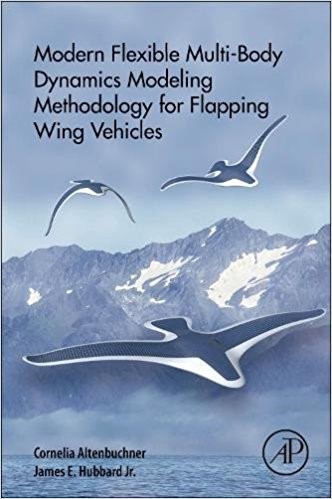 |

|
 |
New book by Hubbard and Altenbuchner titled Modern Flexible Multi-body Dynamics Modeling Methodology for Flapping Wing Vehicles. |
|
Dr. James E. Hubbard, Jr. from the University of Maryland Morpheus Laboratory and Dr. Cornelia Altenbuchner, Robotics Technologist at the NASA Jet Propulsion Laboratory, Pasadena, CA, have published a new book. The book is the second in a series on avian-inspired robots and is titled, Modern Flexible Multi-body Dynamics Modeling Methodology for Flapping Wing Vehicles.
Avian inspired bird-like robotic designs have given rise to modern ornithopters whose aerodynamic and kinematic properties are marginally predictable and produce nonlinear behaviors, which are, time varying and involve multiple dynamic scales. Efforts to model the flight physics of these vehicles are complicated by a number of factors, including nonlinear elastic effects, multi-body characteristics, unsteady aerodynamics, and the strong coupling between fluid and structural dynamics. Experimental verification is crucial in order to achieve accurate simulation capabilities. In Modern Flexible Multi-body Dynamics Modeling Methodology for Flapping Wing Vehicles, the authors present an energy based Lagrangian approach that includes the flexible multi-body dynamics characteristic of this class of platforms. In this book a five-body-flexible-vehicle dynamics model and a novel experimental verification methodology is presented. For the model development and verification of the modeling assumptions, a data set providing refined wing kinematics of a test ornithopter research platform in free flight is used.
Hubbard and Altenbuchner’s book will be a useful reference for postgraduates in Aerospace and Mechanical Engineering, as well as researchers in the field of Multibody Dynamics, Multidisciplinary Modeling and Simulation, and Flapping wing Robotic systems.
Key Features
- Presents a five-body-flexible-vehicle dynamics model and a novel experimental verification methodology
- Develops canonical modeling techniques that can drive the engineering design of avian scale flapping wing ornithopters
- Uses Lagrange equations of motion in terms of a generalized coordinate vector of the rigid and flexible bodies in order to model the flexible multi-body system
- Provides flight verification data and flight physics of highly flexible ornithoptic vehicles
For complete details, or to pre-order a copy, visit the publisher’s website
ISBN-13: 978-0128141366
ISBN-10: 0128141360
August 14, 2017
|

